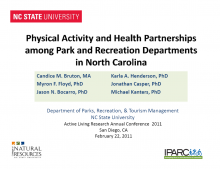We are pleased to announce an exciting new alliance between Active Living Research and GP RED to co-host and coordinate...
Physical Activity and Health Partnerships among Park and Recreation Departments in North Carolina

Presentation at the 2011 Active Living Research Annual Conference
Background: Multi-sectoral, interdisciplinary partnerships are key strategies for promoting and implementing environment and policy changes to increase physical activity (Kumanyika et al., 2008). Such partnerships reflect ecologic frameworks which emphasize interactive and interdependent influences on physical activity and obesity (Sallis et al., 2006). There is growing recognition and rapidly emerging empirical evidence that parks and recreation agencies are essential to multi-sectoral partnerships to promote physical activity (Mowen, 2010; Mowen & Baker, 2009). Yet few studies have examined factors associated with physical activity partnerships involving park and recreation agencies. Such studies are needed to better understand the capacity of park and recreation to engage in and maintain partnerships roles.
Objectives: This study examined the extent of personal characteristics of park and recreation directors and organizational characteristics of their departments that were associated with formal participation in partnerships to promote physical activity.
Methods: A web-based survey was administered to 216 directors from all municipal and county park and recreation agencies in North Carolina in May 2007. Questionnaires were completed by 134 respondents resulting in a 64% response rate. For this analysis, items measuring partnership participation, organization characteristics, and personal director characteristics were of interest. Partnership participation was measured by asking whether a department participated in (1) formal partnerships with a county health department and other community organizations to promote physical activity and (2) formal partnerships with the YMCA, faith-based organizations, and schools. The term formal partnership was specified as a group that shares resources (property, knowledge, activities) and that can act as a formal agent (sign agreements). Responses were coded as "yes" or "no." Organizational characteristics measured included operating budget, capital budget, size of population served, size of staff, and target populations for physical activity programs. Personal characteristics of agency directors were total years of experience (high = > 30 years, medium = 16 - 29 years, low = <15 years), gender, professional certification status (yes or no) and director’s total years in current position (high = 16 years or more and low = <15 years). Chi-square tests were used to test for associations.
Results: Thirty percent of departments participated in partnerships with health departments to promote physical activity. Fifty-six percent of the departments participated in partnerships with other community organizations. Forty-six percent of the departments participated in partnerships with schools. Departments that served larger populations and had larger operating budgets were more likely to engage in a partnership with a health department (X2=12.08, p=.002). Professional certification status of directors (Certified Park and Recreation Professional or CPRP) was positively associated with engaging in a partnership with community organizations (X2=5.25, p=.022). Directors’ total years of experience and years in current position were not associated with partnership participation. Departments that focused their efforts on minorities and obesity among teens were more likely to engage in partnerships with school systems and other community organizations. Staff size was only related to school partnerships. Associations with other variables were not observed for partnerships with health departments, schools, faith-based organizations, YMCA’s, and other community organizations.
Conclusions: Our findings mirror results from previous partnership research (e.g., agencies serving smaller populations with smaller budgets are less likely to engage in health partnerships) (Mowen et al., 2009). The findings have implications for policy makers and park and recreation administrators. For example, the positive association between professional certification (CPRP) of the department director and partnerships suggests that the certification process is beneficial to building relationships between the recreation and parks profession and other community partners. The study also suggests that departments that serve smaller populations may need assistance in identifying partners and sustaining partnerships. Finally, the extent of partnering to promote physical activity in North Carolina is encouraging and there is room for growth in this regard. In particular, partnerships with school systems are promising strategies for creating opportunities for physical activity (Filardo et al., 2010). Future research specific to public park and recreation providers should examine organizational and personal managerial factors contributing to participation and non-participation in greater depth. Contributions, costs, benefits, and evaluation of partnerships must be better understood for the field to effectively promote physical activity. This line of research is increasingly important in a time of agency budget reductions and the persistence of the obesity epidemic.
Support: This project was conducted through an initiative called Investigating Places for Active Recreation in Communities (IPARC) at North Carolina State University funded in part by the North Carolina Forestry Foundation, Inc.
STAY UP TO DATE
RECENTLY ADDED TOOLS & RESOURCES
MOVE! A BLOG ABOUT ACTIVE LIVING
The "Active Living Conference" aims to break down research and practice silos and...







